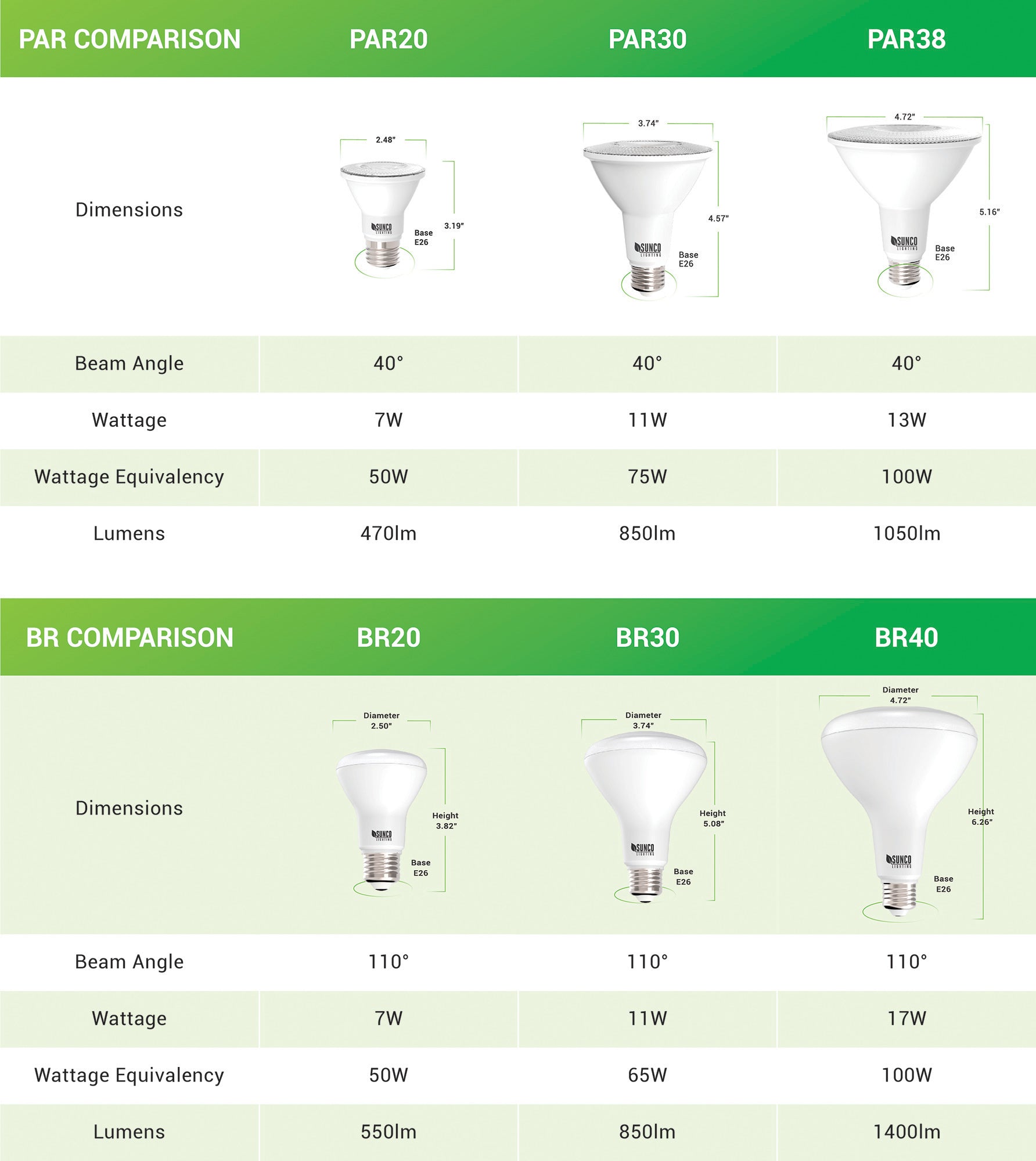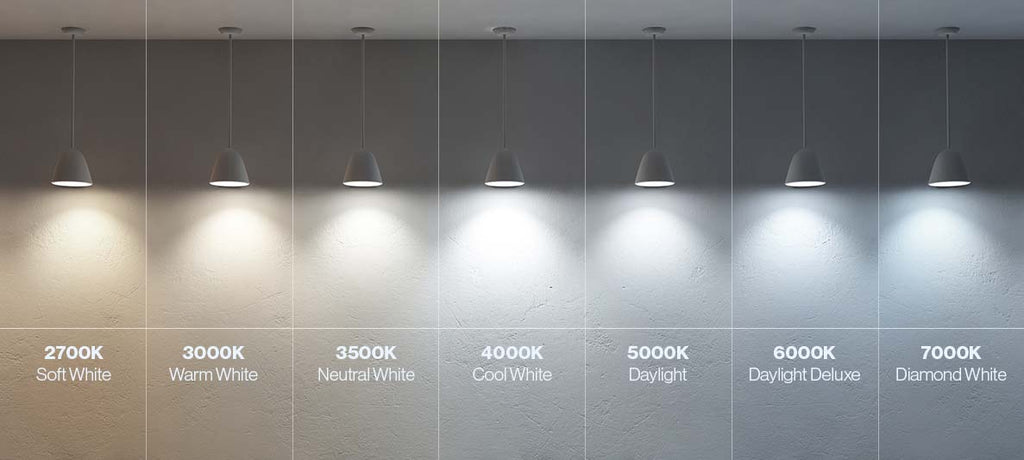What are the Differences Between PAR and BR Bulbs?
While both PAR and BR bulb types rely on a reflector to direct the light beam, are dimmable, use 120VAC, and feature an E26 base, there are major differences in the light produced by each bulb. There are also some unique qualities about LED PAR and LED BR bulbs.
The major difference in light produced by these LED bulbs:
- PARs produce a spotlight (a narrow beam)
- BR bulbs are considered to be a flood light (wide beam angle)
This blog will help you choose the right bulb for your next lighting project as you learn the differences between the bulb styles and varied sizes Sunco sells.
What do the Numbers on PAR & BR Bulb Names Mean?
Manufacturers use standard numbers like PAR30 or BR30 to indicate the bulb size. The number indicates the diameter of the lamp portion, not the base of the bulb. Diameter for these two bulb types is measured in eighths of an inch. Example: BR30 = 30/8 inches or approximately 3 ¾”
Sunco PAR Diameters:
PAR20 = 2.48”
PAR30 = 3.74”
PAR38 = 4.72”
Sunco BR Diameters:
BR20 = 2.5”
BR30 = 3.74”
BR40 = 4.72”
Notice that a PAR30 is the same diameter as a BR30 bulb. You can swap these bulb types to change from wide to spot, depending on what you need in each location.
BR and PAR LED replacements for your traditional flood or spotlight bulbs not only create a different style light beam from each other, the bulbs also look different. More on the light produced later.
In addition, both Sunco PAR and BR bulbs feature CRI80 for accurate color rendering and clear definition of textures.
Let’s examine the bulbs themselves.
How to Identify Your Reflector Bulb
The internal reflector of traditional PAR and BR bulb types redirects downcast light to the front of the bulb to make the most of the light produced. LED bulbs do not require a reflector to produce the same light due to the technology used. Incandescent and other reflector bulbs still require that. And you thought energy efficiency was the only difference between traditional bulbs and LEDs.
Although LEDs do not require a reflector, manufacturers continue to create the same bulb shape as the reflector bulbs you used to purchase in the past.
The physical shape of a PAR and BR bulb, including the diameter size (see chart below for more specs), is a quick way to identify a bulb. Also note: BR bulbs may extend past the end of a can, while PARs sit lower inside a recessed can, due to the variance in length.

PAR BULBS
PAR bulbs (Parabolic Aluminized Reflector) combine the lamp, reflector, and pressed lens into a single unit within the lamp. PARs are more suited to exterior applications, some are even waterproof. Also, note that PAR bulbs tend to have a high lumen count to provide a bright light.
When compared to a BR light, PARs produce a crisper edge. However, Sunco PARs generate direct light with softened edge shadows.
PAR bulbs range between 2.48” to approximately 4.75” in diameter. Their body is a bit shorter than a BR. Instead of a bulbous shape, PARs tend to have a bowl shape, similar to those you use as vehicle headlights.
If you look across the entire lighting industry, specialty PAR lights are used in theatrical and film lighting, along with automotive applications.
BR BULBS
Traditional BR bulbs include a bulged reflector on the inside of the housing to increase light output. You will notice the bulging shape on our BR LEDs above the socket base (when looking at the bulb from the side like in the graph above). Sunco BR bulbs produce a wide beam angle to illuminate a large area as directional flood lights. In other words, they cast a wide pool of light.
The light BR bulbs produce is of a softer quality. Some might say the edges are not as crisp. The soft-edge of the light beam produced by Sunco BR LED Bulbs will create a nice wall wash in interior light fixtures or a great downlight to illuminate a space in a recessed ceiling can. Note that BR bulbs tend to produce fewer shadows than a PAR.
The beam angle of each bulb affects the shape of the light produced.
PAR & BR Bulb Beam Angles
The beam angles are where the differences really appear. As mentioned, these lights produce either a narrow spot and highly directional beam (PAR) or a wide flood (BR).
Sunco BR & PAR Beam Angles:
- PARs: 40°
- BRs: 110°

As you can see from the beam angle graphic above, choosing a bulb with a narrower beam angle, like the PARs (40°), will create a directional spotlight.
Our Lighting 101 page includes a detailed explanation about beam angles, in case you want to know more.
A discussion about light shape and quality would not be complete without a review of warm or cool tones and your color choices.
Color Choices with PAR & BR Bulbs
You can select from warm to cool light quality when you purchase a PAR or BR bulb. Sunco’s color temperatures include warmer colors under 3000K (Warm White), which appears yellow. Color tends to shift to cool when you reach 4000K (Cool White). The cool 6000K (Daylight Deluxe) appears silver in nature to our eyes.
- Sunco PAR20/PAR30 bulbs range from 2200K (Amber Glow/Red) - 6000K (Daylight Deluxe/Silver)
- Sunco PAR38 bulbs range from 2700K (Soft White/Orange) -5000K (Daylight/Blue)
- Sunco BR bulbs range from 2200K (Amber Glow/Red) - 6000K (Daylight Deluxe/Silver)
Still unsure how color temperature works? You can learn more about the colors Sunco offers in our Lighting 101 page or check out our detailed blog about Correlated Color Temperature (CCT) to better understand warm and cool light.
Now that you know the bulb sizes, features, and light quality, where can you use them?
Applications of PAR & BR Bulbs
PAR BULBS
PAR bulbs are often used in key lighting due to their spot-like light spread (beam angle 40°). They function well in restaurants, bars, and exterior applications. Depending on their size, Sunco PAR LEDs are ideal for track lighting, exterior landscaping, uplights for trees or sculptures, and as downlights in recessed cans. They also work well in houses of worship, art galleries, museums, and in showrooms or retail lighting to accent or highlight specific artwork or retail products.
PARs are not exclusively for outdoor use, though several Sunco PAR bulbs are wet rated for outdoor use. A wet rating makes these lights ideal for focused light in garden and landscaping applications, as well as spotlights for exterior business or retail signs. If you are unsure about applications for wet vs. dam rated lights, you can check out our blog to learn more.
You can also use PARs in exterior security lighting, too. Some offer Dusk to Dawn properties and can automatically turn on at night when the included photocell sensor detects an absence of light.
BR BULBS
BR Bulbs work well in recessed cans (that accept an E26 base) in your kitchen, hallway, stairwell or family room. Their wide beam angle makes them ideal as a wall wash and general room illumination inside a ceiling fixture or downlight. They also work very well above kitchen counters for bright, task oriented light.
Both BR and PAR LED bulbs are ideal replacements for your energy consuming incandescent or halogen lights since they draw less power. Now that you have a better idea about the differences between BR bulbs and PAR bulbs you are all set to select the bulb that is appropriate for your unique lighting project. If you still aren’t sure what is right for you, please reach out to our customer service team.



Lynn